Seismic Response of Foundation Settlement for Liquid Storage Structure in Collapsible Loess Areas
Abstract
1. Introduction
2. Finite Element Analysis Model
2.1. Engineering Background
2.2. Ground Motion
2.3. Analysis Model
3. Dynamic Response of Local Foundation Failure
3.1. Dynamic Response of LSS under Working Condition II
3.2. Dynamic Response of LSS under Working Condition III
3.3. Dynamic Response of LSS under Working Condition IV
4. Displacement Dynamic Response Rule of LSS
5. Conclusions
- (1)
- Different types of foundation failure conditions lead to varied dynamic response results of LSS, causing different increases in wall displacement and potentially resulting in structural failure due to excessive deformation. Therefore, ensuring the safety of the foundation in loess areas is particularly crucial for the safe operation of LSSs.
- (2)
- The foundation collapse of LSS leads to varying degrees of increase in equivalent stress, maximum shear stress, wall displacement, and liquid sloshing wave height. These increases vary depending on different conditions.
- (3)
- Under seismic loading, the dynamic response patterns of LSSs differ across different conditions. Comparing the dynamic response results under different conditions, working condition III has a relatively minor impact on the results, while working condition IV has the greatest impact on the structural dynamic response.
- (4)
- The dynamic response patterns of LSSs are directly related to the direction of seismic loading. Compared to the seismic excitation along the X-axis, the structural dynamic response is more pronounced when simultaneously subjected to seismic excitation along the X-Z-axis.
Author Contributions
Funding
Institutional Review Board Statement
Informed Consent Statement
Data Availability Statement
Conflicts of Interest
References
- Westergaard, H.M. Water pressures on dams during earthquakes. Am. Soc. Civ. Eng. 1933, 98, 418–433. [Google Scholar] [CrossRef]
- Housner, G.W. Dynamic pressure on accelerated fluid container. Bull. Seismol. Soc. Am. 1957, 47, 15–35. [Google Scholar] [CrossRef]
- Haroun, M.A. Vibration studies and tests of liquid storage tanks. Earthq. Eng. Struct. Dyn. 1983, 11, 179–206. [Google Scholar] [CrossRef]
- Livaoglu, R. Investigation of seismic behavior of fluid-rectangular tank-soil/foundation systems in frequency domain. Soil Dyn. Earthq. Eng. 2008, 28, 132–146. [Google Scholar] [CrossRef]
- Tang, Y.G.; Zhang, Z.S.; Li, C.S.; Yang, C.H. Fluid velocity potential and simplified model for unanchored storage tanks. J. Water Resour. 1997, 9, 42–47. [Google Scholar]
- Hwang, T.; Ting, K. Boundary element method for fluid-structure interaction problems in liquid storage tanks. Journal of pressure Vessel Technology. Trans. ASME 1989, 111, 435–440. [Google Scholar]
- Fan, X.Z.; Zheng, T.X.; Wang, W.; Wu, L.Y.; He, X. Simulation analysis of “elephant foot” deformation of vertical liquid storage tank wall under seismic action. Earthq. Eng. Eng. Vib. 2007, 27, 104–109. [Google Scholar]
- Sun, J.G.; Wang, Z.; Wang, X.N.; Yang, Y. Finite element analysis of three-dimensional seismic response of floating storage tank. Earthq. Eng. Eng. Vib. 2008, 28, 191–199. [Google Scholar]
- Zhang, Y.; Guan, Y.H. Seismic Response analysis of large liquid storage tanks. Appl. Mech. Mater. 2012, 1799, 2490–2493. [Google Scholar] [CrossRef]
- Liu, D.Y.; Fang, Z. Experimental and Numerical simulation investigation on dynamic response of liquid storage tanks under seismic excitations. Appl. Mech. Mater. 2014, 2963, 763–766. [Google Scholar] [CrossRef]
- Xi, C.S.; Zeng, X.W.; Pu, M. Analysis of dynamic characteristics and seismic response of vertical cylindrical oil storage tank. Pet. Eng. Constr. 2016, 42, 11–17. [Google Scholar]
- Zhang, R.; Cheng, X.; Guan, Y.; Tarasenko, A.A. Seismic response analysis of an unanchored vertical vaulted-type tank. Earthq. Struct. 2017, 13, 67–77. [Google Scholar]
- Cheng, X.S.; Jing, W.; Gong, L.J. Dynamic responses of a sliding base-isolated RLSS considering free surface liquid sloshing. KSCE J. Civ. Eng. 2018, 22, 4964–4976. [Google Scholar] [CrossRef]
- Cheng, X.; Liu, B.; Cao, L.; Yu, D.; Feng, H. Dynamic response of a base-isolated CRLSS with baffle. Structural Engineering and Mechanics. Int. J. 2018, 66, 411–421. [Google Scholar]
- Cheng, X.S.; Jing, W.; Li, D. Dynamic response of concrete tanks under far-field, long-period earthquakes. Proc. Inst. Civ. Eng.—Struct. Build. 2019, 174, 1–37. [Google Scholar] [CrossRef]
- Luo, D.; Liu, C.; Sun, J.; Cui, L.; Wang, Z. Sloshing effect analysis of liquid storage tank under seismic excitation. Structures 2022, 43, 40–58. [Google Scholar] [CrossRef]
- Jing, W.; Shen, J.; Cheng, X.; Yang, W. Seismic responses of a liquid storage tanks considering structure-soil-structure interaction. Structures 2022, 45, 2137–2150. [Google Scholar] [CrossRef]
- Hernandez, D.; Larkin, T.; Chouw, N. Lid induced sloshing suppression and evaluation of wall stresses in a liquid storage tanks including seismic soil-structure interaction. Earthq. Eng. Struct. Dyn. 2022, 51, 2708–2729. [Google Scholar] [CrossRef]
- Wang, J.; Guo, T.; Du, Z.; Yu, S. Shaking table tests and parametric analysis of dynamic interaction between soft soil and structure group. Eng. Struct. 2022, 256, 114041. [Google Scholar] [CrossRef]
- Kumar, H.; Saha, S.K. Effects of soil-structure interaction on seismic response of fixed base and base isolated liquid storage tanks. J. Earthq. Eng. 2022, 26, 6148–6171. [Google Scholar] [CrossRef]
- Jaramillo, F.; Almazán, J.L.; Colombo, J.I. Effects of the anchor bolts and soil flexibility on the seismic response of cylindrical steel LSSs. Eng. Struct. 2022, 263, 114353. [Google Scholar] [CrossRef]
- Sun, Y.; Cui, L.F.; Sun, J.G.; Cheng, L.H. Energy dissipation damping analysis of vertical storage tanks in service based on SMA dampers. Struct. Eng. 2021, 37, 64–76. [Google Scholar]
- Tian, L.L.; Liang, X.Q. Analysis of causes of uneven settlement of storage tank groups on deep backfill foundations and correction and reinforcement treatment. Found. Treat. 2022, 4, 414–422. [Google Scholar]
- Li, B.; Meng, M.J.; Shao, W.T. Numerical simulation of uneven subsidence of soft ground foundation of oil storage tank based on finite element analysis. Urban Roads Bridg. Flood Control 2022, 279, 191–196. [Google Scholar]
- Liu, Z.; Zhang, H.Y.; Qin, K. Deformation and force analysis of large liquid storage tank and foundation ring wall based on FLAC3D. Guangdong Chem. Ind. 2022, 49, 172–174+184. [Google Scholar]
- Wu, J.H. Analysis of Seismic Dynamic Response of LSS under Uneven Settlement of Foundation; Zhejiang University: Hangzhou, China, 2021. [Google Scholar]
- China Academy of Building Research. Code for Seismic Design of Buildings, 2016th ed.; Architecture & Building Press: Beijing, China, 2016. [Google Scholar]
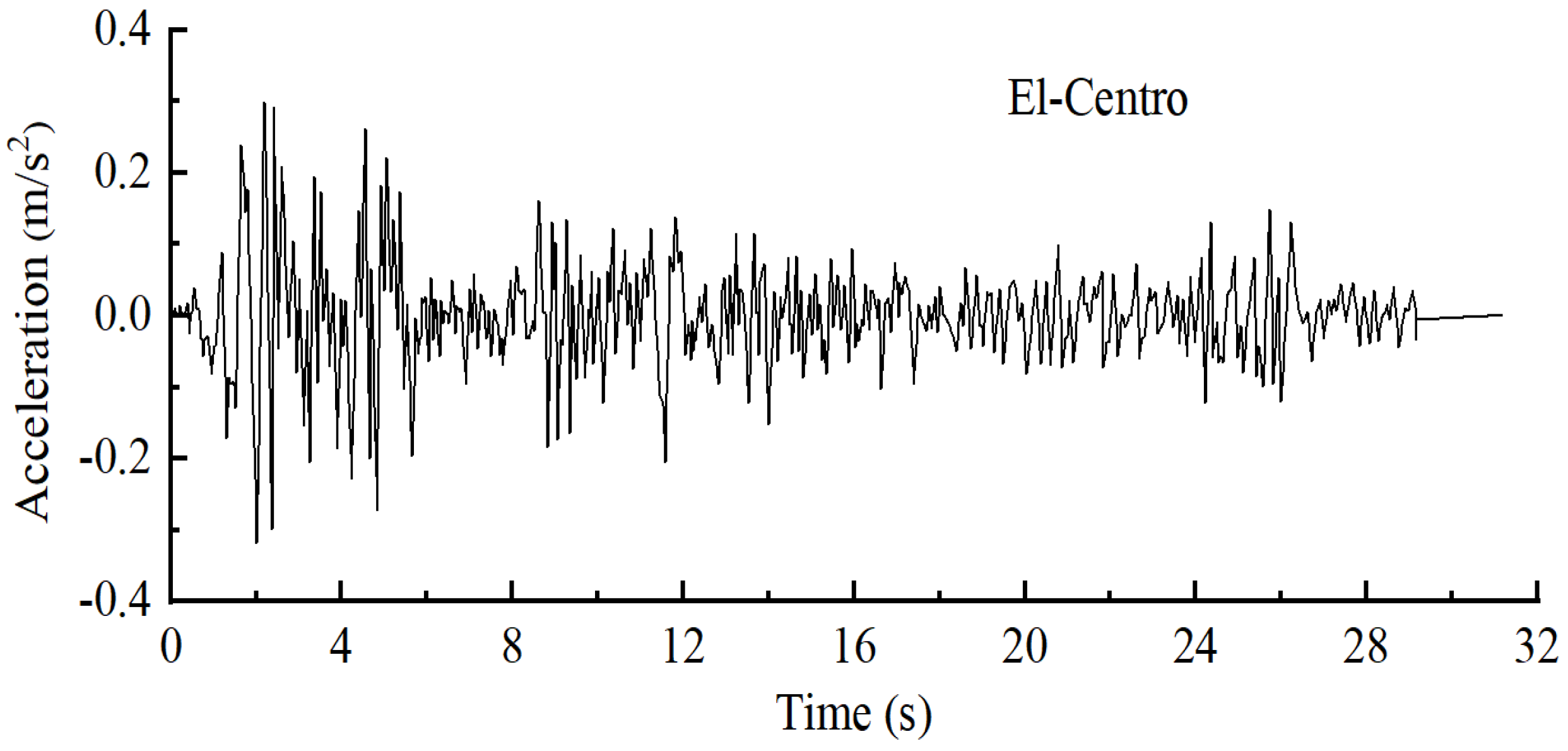




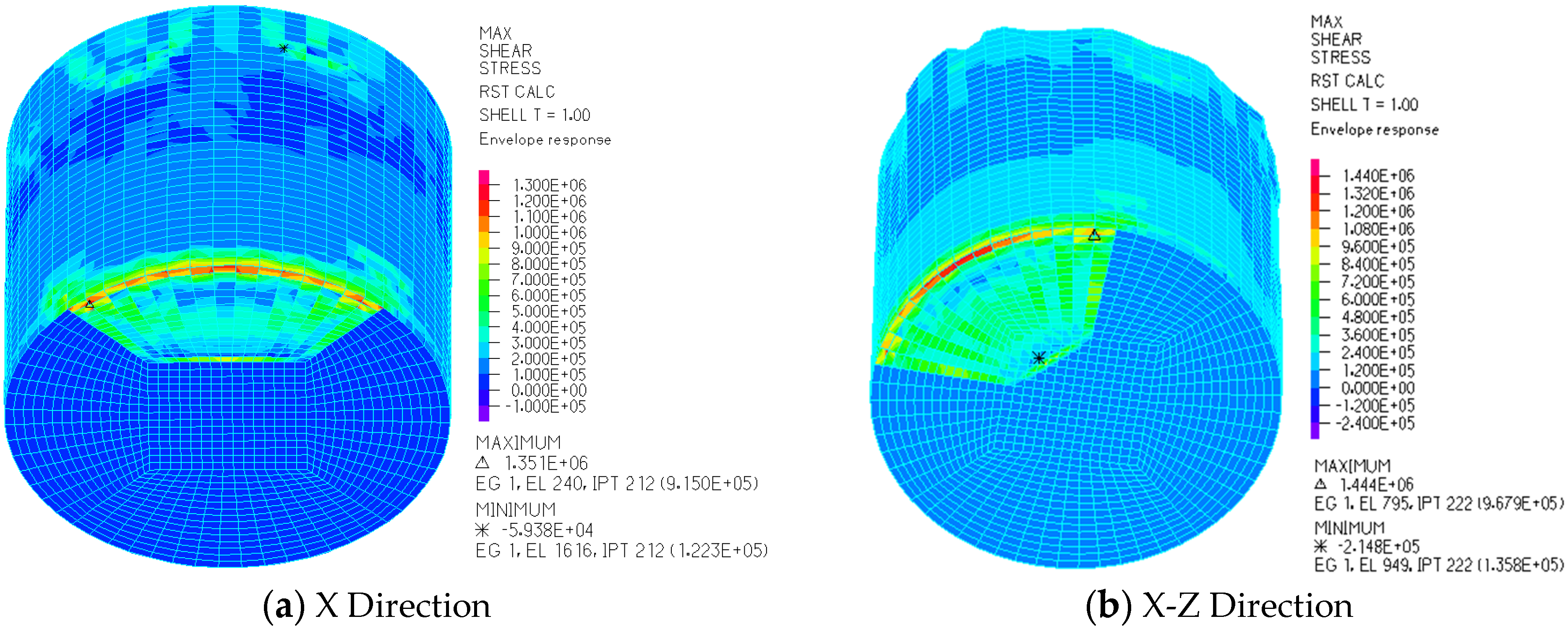

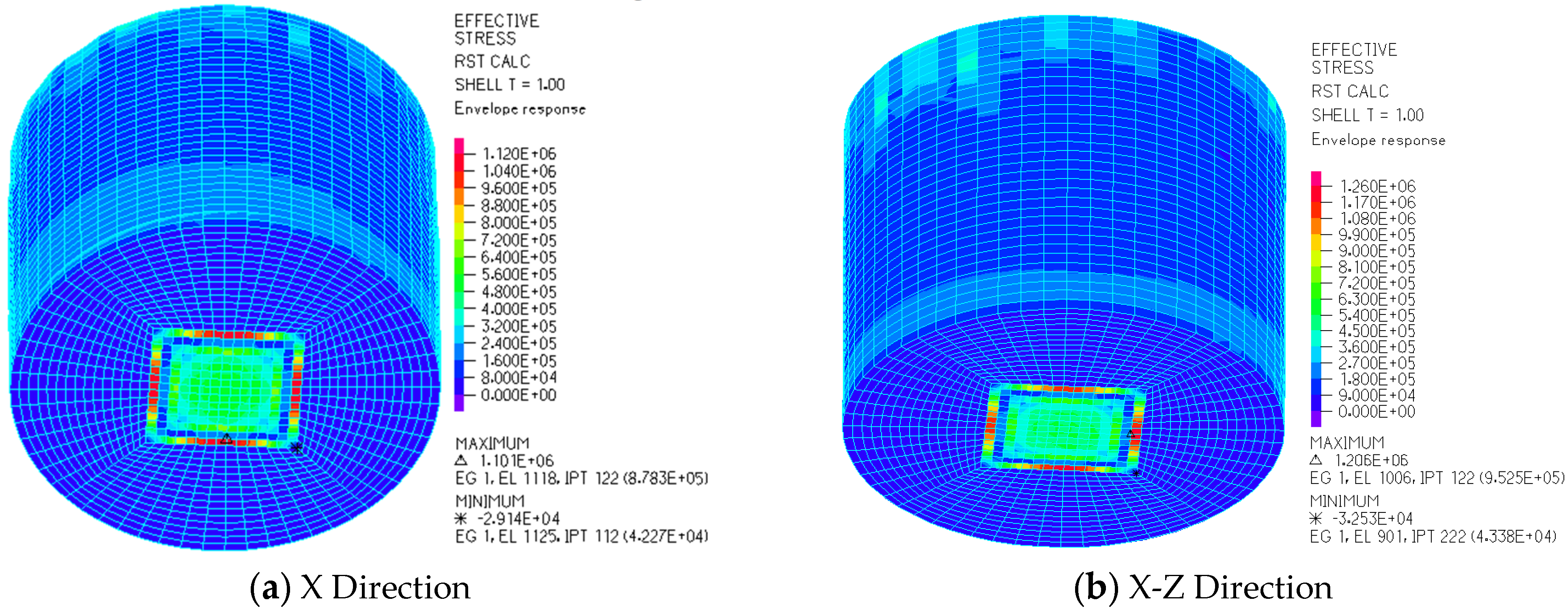
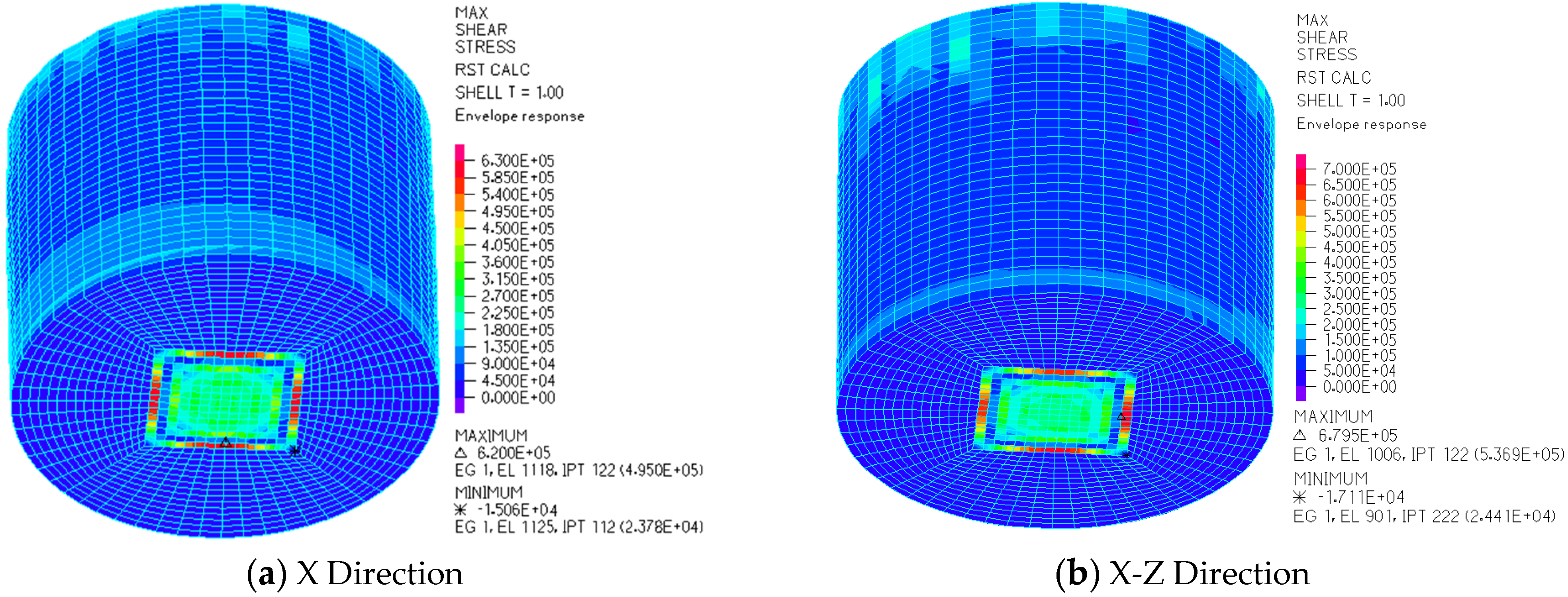
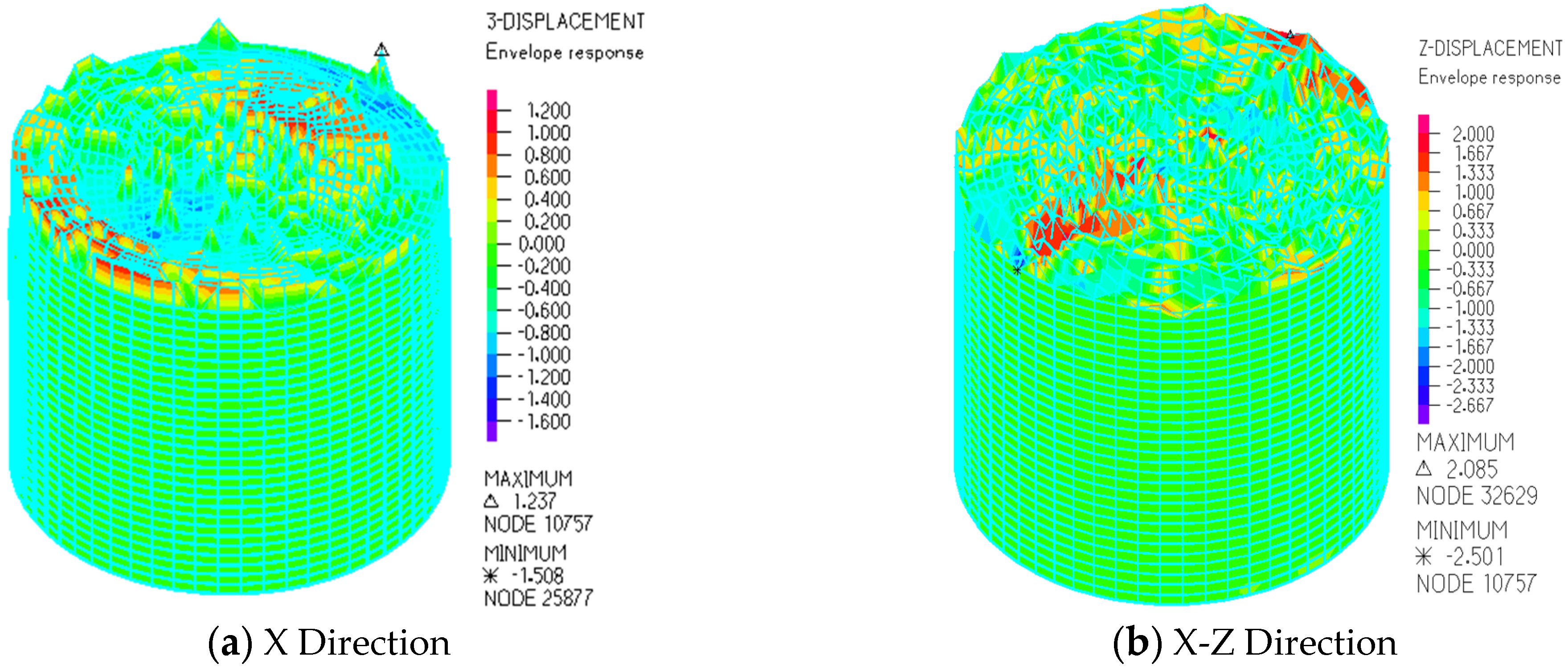
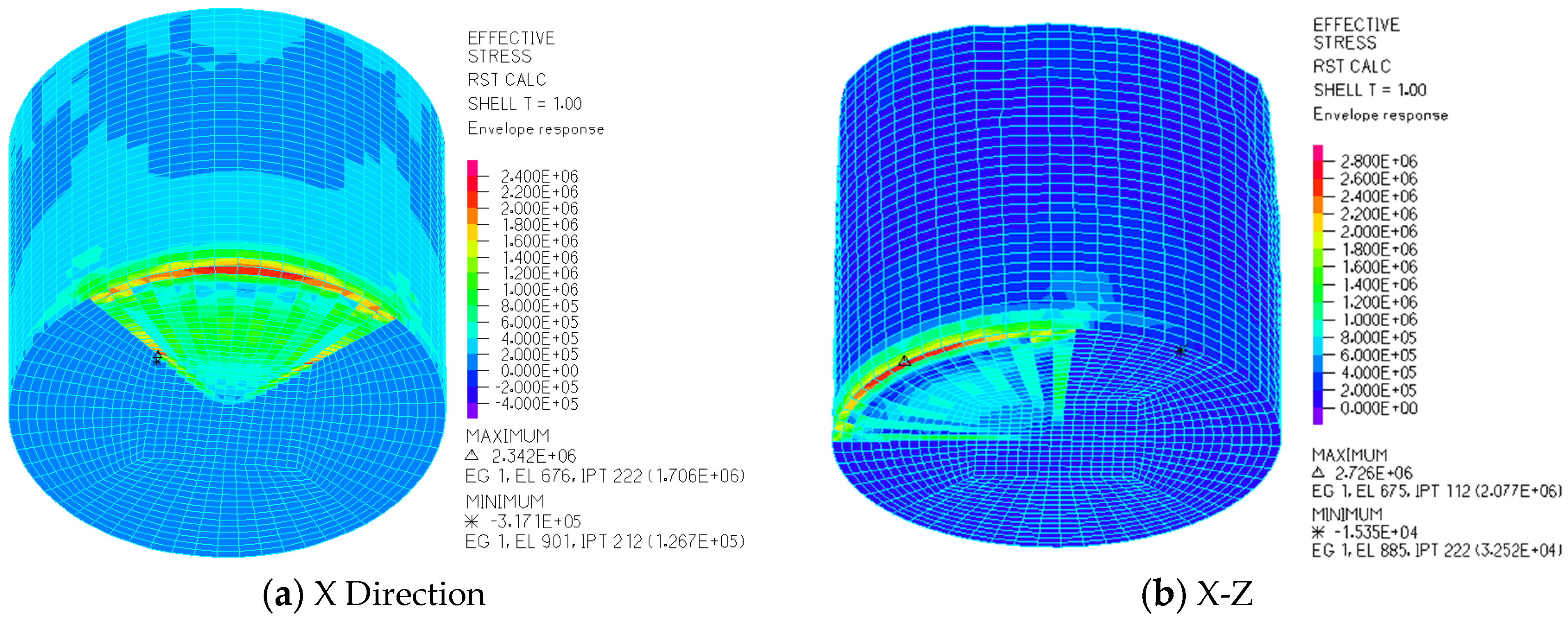

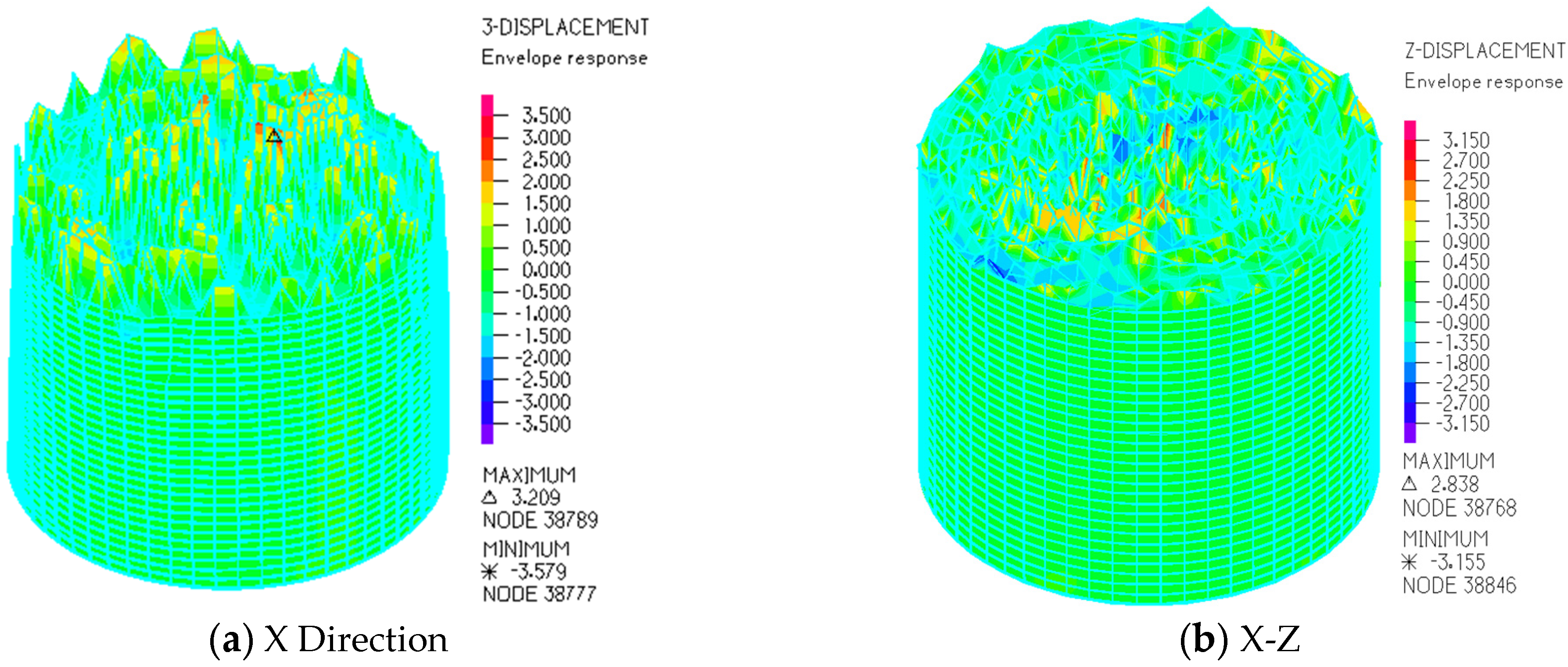
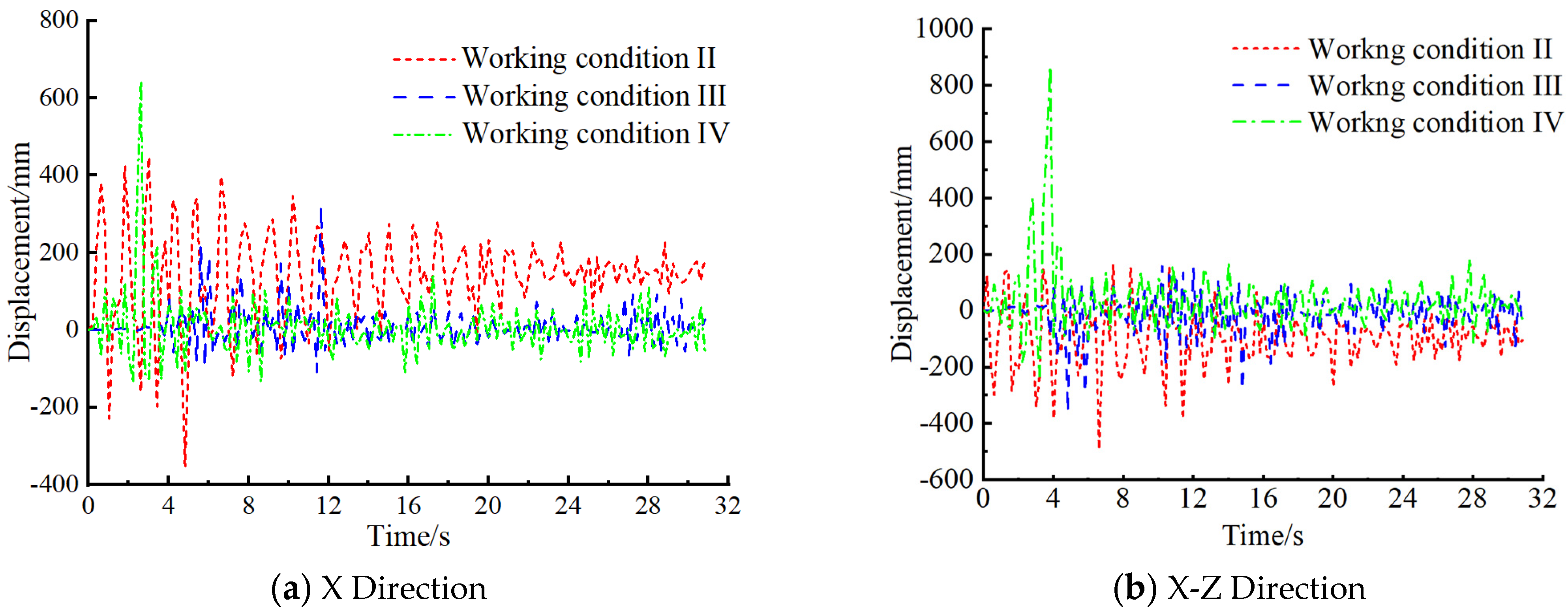
| Exploration Well Number | Soil Layer Distribution Depth /m | Self-Weight Collapsibility Content Δzs/mm | Collapsibility Value Δs/mm | Collapsible Level |
|---|---|---|---|---|
| ZK4 | 7.25 | 78.75 | 177.98 | Grade II self-weight |
| ZK6 | 6.75 | 0.00 | 224.13 | Grade I non-weight |
| ZK14 | 7.25 | 0.00 | 237.38 | Grade I non-weight |
| Soil | Layer Thickness h/m | Density ρ /kg/m3 | Elastic Modulus E/MPa | Poisson’s Ratio ν | Cohesion c/kPa | Internal Friction Angle ψ/° |
|---|---|---|---|---|---|---|
| Plain fill | 3.8 | 1646 | 4.7 | 0.38 | 8 | 14 |
| Silty clay | 2.4 | 1790 | 5.52 | 0.30 | 15 | 22 |
| Pebble | 6.3 | 2100 | 50 | 0.17 | 0 | 38 |
| Strongly weathered sandstone | 4 | 2230 | 45 | 0.23 | 2 | 30 |
| Moderately weathered sandstone | 43.5 | 2250 | 50 | 0.20 | 25 | 32 |
Disclaimer/Publisher’s Note: The statements, opinions and data contained in all publications are solely those of the individual author(s) and contributor(s) and not of MDPI and/or the editor(s). MDPI and/or the editor(s) disclaim responsibility for any injury to people or property resulting from any ideas, methods, instructions or products referred to in the content. |
© 2024 by the authors. Licensee MDPI, Basel, Switzerland. This article is an open access article distributed under the terms and conditions of the Creative Commons Attribution (CC BY) license (https://creativecommons.org/licenses/by/4.0/).
Share and Cite
Huang, W.; Cao, X.; Xie, H.; Sun, H.; Cheng, X. Seismic Response of Foundation Settlement for Liquid Storage Structure in Collapsible Loess Areas. Appl. Sci. 2024, 14, 8993. https://doi.org/10.3390/app14198993
Huang W, Cao X, Xie H, Sun H, Cheng X. Seismic Response of Foundation Settlement for Liquid Storage Structure in Collapsible Loess Areas. Applied Sciences. 2024; 14(19):8993. https://doi.org/10.3390/app14198993
Chicago/Turabian StyleHuang, Wenji, Xianhui Cao, Hongyi Xie, Haodong Sun, and Xuansheng Cheng. 2024. "Seismic Response of Foundation Settlement for Liquid Storage Structure in Collapsible Loess Areas" Applied Sciences 14, no. 19: 8993. https://doi.org/10.3390/app14198993
APA StyleHuang, W., Cao, X., Xie, H., Sun, H., & Cheng, X. (2024). Seismic Response of Foundation Settlement for Liquid Storage Structure in Collapsible Loess Areas. Applied Sciences, 14(19), 8993. https://doi.org/10.3390/app14198993







